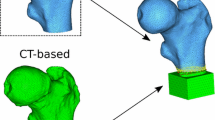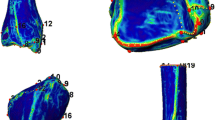Abstract
Measurement of bone mineral density (BMD) by DXA (dual-energy X-ray absorptiometry) is generally considered to be the clinical golden standard technique to diagnose osteoporosis. However, BMD alone is only a moderate predictor of fracture risk. Finite element analyses of bone mechanics can contribute to a more accurate prediction of fracture risk. In this study, we applied a method to estimate the 3D geometrical shape of bone based on a 2D BMD image and a femur shape template. Proximal femurs of eighteen human cadavers were imaged with computed tomography (CT) and divided into two groups. Image data from the first group (N = 9) were applied to create a shape template by using the general Procrustes analysis and thin plate splines. This template was then applied to estimate the shape of the femurs in the second group (N = 9), using the 2D BMD image projected from the CT image, and the geometrical errors of the shape estimation method were evaluated. Finally, finite element analysis with stance loading condition was conducted based on the original CT and the estimated geometrical shape to evaluate the effect of the geometrical errors on the outcome of the simulations. The volumetric errors induced by the shape estimation method itself were low (<0.6%). Increasing the number of bone specimens used for the template decreased the geometrical errors. When nine bones were used for the template, the mean distance difference (±SD) between the estimated and the CT shape surfaces was 1.2 ± 0.3 mm, indicating that the method was feasible for estimating the shape of the proximal femur. Small errors in geometry led systematically to larger errors in the mechanical simulations. The method could provide more information of the mechanical characteristics of bone based on 2D BMD radiography and could ultimately lead to more sensitive diagnosis of osteoporosis.
Similar content being viewed by others
References
Bergmann G, Deuretzbacher G, Heller M et al (2001) Hip contact forces and gait patterns from routine activities. J Biomech 34: 859–871
Bland M, Altman D (1986) Statistical methods for assessing agreement between two methods of clinical measurement. Lancet 327: 307–310
Bookstein F (1989) Principal warps: thin-plate splines and the decomposition of deformations. IEEE Trans Pattern Anal 11: 567–585
Cody D, Gross G, Hou FJ et al (1999) Femoral strength is better predicted by finite element models than QCT and DXA. J Biomech 32: 1013–1020
Dryden I, Mardia K (1998) Statistical shape analysis. Wiley, New York
Edwards W, Gillette J, Thomas J et al (2008) Internal femoral forces and moments during running: implications for stress fracture development. Clin Biomech 23: 1269–1278
Fang Q, Boas DA (2009) Tetrahedral mesh generation from volumetric binary and grayscale images. In: International symposium on biomedical imaging: from nano to macro. IEEE, Boston, Massachusetts, USA
Filippi S, Motyl B, Bandera C (2007) Analysis of existing methods for 3D modelling of femurs starting from two orthogonal images and development of a script for a commercial software package. Comput Meth Prog Bio 89: 76–82
Gower J (1975) Generalized procrustes analysis. Psychometrika 40: 33–51
Keyak J, Falkinstein Y (2003) Comparison of in situ and in vitro CT scan-based finite element model predictions of proximal femoral fracture load. Med Eng Phys 25: 781–787
Keyak J, Rossi S, Jones K et al (2001) Prediction of fracture location in the proximal femur using finite element models. Med Eng Phys 23: 657–664
Keyak J, Rossi S, Jones K et al (1998) Prediction of femoral fracture load using automated finite element modeling. J Biomech 31: 125–133
Kolta S, Le Bras A, Mitton D et al (2005) Three-dimensional X-ray absorptiometry (3D-XA): a method for reconstruction of human bones using a dual X-ray absorptiometry device. Osteoporos Int 16: 969–976
Langton C, Pisharody S, Keyak J (2009) Comparison of 3D finite element analysis derived stiffness and BMD to determine the failure load of the excised proximal femur. Med Eng Phys 31: 668–672
Langton C, Pisharody S, Keyak J (2009) Generation of a 3D proximal femur shape from a single projection 2D radiographic image. Osteoporos Int 20: 455–461
Laporte S, Skalli W, De Guise J et al (2003) A biplanar reconstruction method based on 2D and 3D contours: application to the distal femur. Comput Methods Biomech Biomed Engin 6: 1–6
Morgan E, Bayraktar H, Keaveny T (2003) Trabecular bone modulus–density relationships depend on anatomic site. J Biomech 36: 897–904
Pasco J, Seeman E, Henry M et al (2006) The population burden of fractures originates in women with osteopenia, not osteoporosis. Osteoporos Int 17: 1404–1409
Wirtz D, Pandorf T, Portheine F et al (2003) Concept and development of an orthotropic FE model of the proximal femur. J Biomech 36: 289–293
Author information
Authors and Affiliations
Corresponding author
Rights and permissions
About this article
Cite this article
Väänänen, S.P., Isaksson, H., Julkunen, P. et al. Assessment of the 3-D shape and mechanics of the proximal femur using a shape template and a bone mineral density image. Biomech Model Mechanobiol 10, 529–538 (2011). https://doi.org/10.1007/s10237-010-0253-3
Received:
Accepted:
Published:
Issue Date:
DOI: https://doi.org/10.1007/s10237-010-0253-3




